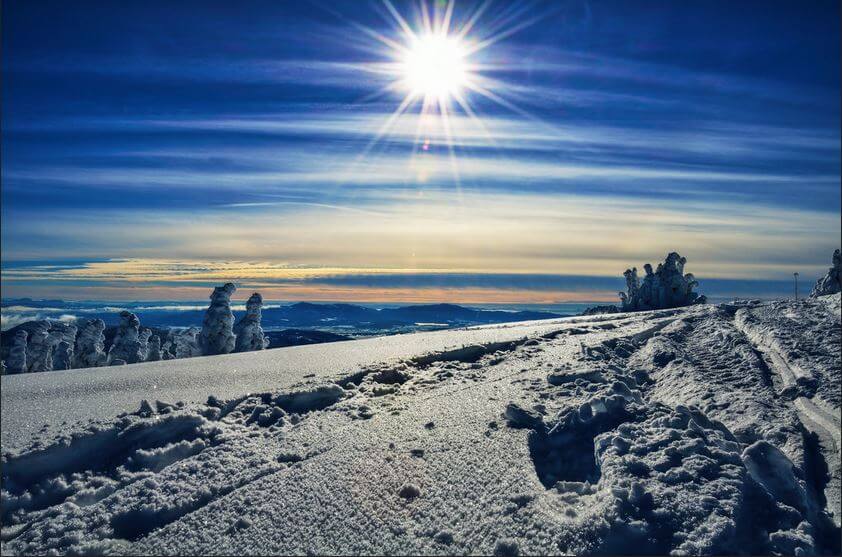Low snow in your area this year? Warm temperatures? Climate change to blame? What are you doing to make a difference? Better yet, what’s your local hill doing to ensure snow for years to come? It might be shocking to find out that more ski area patrons will be able to experience cleaner air and better views. Why? More than 75% of ski resorts have made a transition…They have gone “Green.” As a matter of fact, many are now using 100% renewable energy. Not only are these resorts making a statement by installing wind, hydroelectric, solar, bio-mass and geothermal, but they are pushing Washington to implement legislation to combat global warming.
It seems almost inevitable. Rising temperatures threaten the resort’s livelihood. Increased snowmaking operation with the threat of closing early due to lack of snow are very real for these businesses. Luckily industry leaders recognized these facts and have made preserving the environment and natural surroundings top priority.
In 2000, the National Ski Area Association created the Sustainable Slopes Program. The goal was to help ski resorts reduce their carbon footprint. After 14 years, most resorts in the U.S. have embraced the charter. Here are some of the industry leaders and their efforts.

Squaw Valley, CA
Squaw Valley is consistently near the top of every eco-friendly ski resort list, for good reason. The resort goes above and beyond in the area of habitat protection. They are always trying to improve ski terrain without encroaching upon new areas. This method protects native species and their habitats. Squaw is a village-based resort, which reduces commuters in favor of guests walking to and bussing to lifts.
Aspen/Snowmass, CO
Aspen Mountain scores highly on all lists for water conservation efforts and water quality. The Aspen Ski Company was one of the first ski corporations to turn to wind power. They are now off-setting 100 percent of electricity. Even their groomers use bio-diesel.
Sugar Bowl, CA
As the founding member of the Sierra Green Building Association, whose mission is to promote environmental design in the community, the Sugar Bowl team is also pursuing long-term restoration of natural surroundings and habitats. They’re focus is committed to preserving the beauty of the natural landscape.
Sundance Resort, UT
In recent years Sundance received high marks for habitat protection by Ski Area Citizens, and is committed to renewable wind energy. Not only are they making tremendous “Green” efforts, but Sundance offers their guests access to a full-time naturalist on site, and in winter, conducts their Sundance Ski Ecology program, which includes a guided nature and ecological tour of the mountain.
Mt. Bachelor, OR
Over the last couple years, Mt. Bachelor hired an in house climatologists to conduct environmental studies on the mountain, in order to establish a long-term plan for reducing the resort’s carbon footprint. They are analyzing waste and recycling efforts to maximize efficiency. The resort has already began using transitional fuel, recycled cooking oil for bio-fuel, green cleaners for housekeeping purposes, and recycled paper for warm-beverage cups.
Northstar California, CA
Northstar sets itself apart in eco-friendliness. A real emphasis has been put on recycling. Additionally, Northstar donates wood pallets to a local firewood distributor for reuse as firewood. Recent numbers show they have diverted over 300 tons of material from landfills.
Alpine Meadows, CA
Alpine Meadows, owned in conjunction with eco-friendly Squaw Valley, consistently performs well in habitat protection, and urges its employees to use public transit (and pays for it). A perfect example of large resorts successfully reducing their carbon footprint.
Park City Mountain Resort, UT
Park City also goes the extra mile when it comes to habitat protection. They do so by maintaining undisturbed land to water quality conservation. They are even doing the little things right such as investments in more efficient lighting and fuel. Park City even conducts what it calls an ‘energy audit’ on the whole mountain. They tout reducing their carbon footprint by thousands of tons on their website.
So, even though we are not there yet the snow sports community is making strides and improvements to ensure the past time we love is sustainable from top to bottom. When planning your next adventure take conservation into consideration. Every little bit counts!











